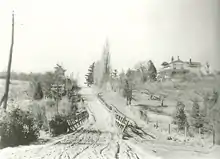Eglinton, Ontario
Eglinton was a small farming village located at what is today the intersection of Yonge Street and Eglinton Avenue in York County, Ontario, Canada. It was first settled in the early 19th century and became the agricultural hub for the area just north of the city of Toronto. During the early 19th century, the area was part of the largest cattle-grazing region in Upper Canada (now the southern region of Ontario). The region was the first in North America to extend the use of cowbells to all cattle. Prior to this, it had been standard practice for a cowbell to be attached only to the best and leading animal in a group of livestock.[1] To honour this proud and storied heritage, the City of Toronto named a local street Cowbell Lane.[2]

The village was also an important stop on Yonge Street, the main road north from Toronto. One of the first settlers was John Montgomery, who founded a tavern catering to travelers. He likely named the village after the Earls of Eglinton, who had the family name Montgomerie and with whom he believed he had some connection. The name of the village would later be given to the east-west trail running through it, which would become Eglinton Avenue. In 1837 Montgomery's Tavern served as the base of William Lyon Mackenzie's rebels and was the site of the Battle of Montgomery's Tavern.
A successful village of 700 people, the area's character changed in 1884 when the Metropolitan Street Railway began running a horse-drawn streetcar up Yonge Street to the village. Rapid housing development soon followed. As the population grew, the settlement was in 1890 incorporated with the smaller Davisville Village into the town of North Toronto. North Toronto was annexed to Toronto two decades later.
References
- "A Brief History of Toronto", Maclean's Magazine, Dec. 1991, p43
- "Naming of Public Lane Located East of Yonge Street Between Eglinton Avenue East and Soudan Avenue" (PDF). 2009-06-01. Retrieved 2011-03-05.
- F. R. Berchem. Opportunity Road: Yonge Street 1860-1939 Dundurn, 1996.